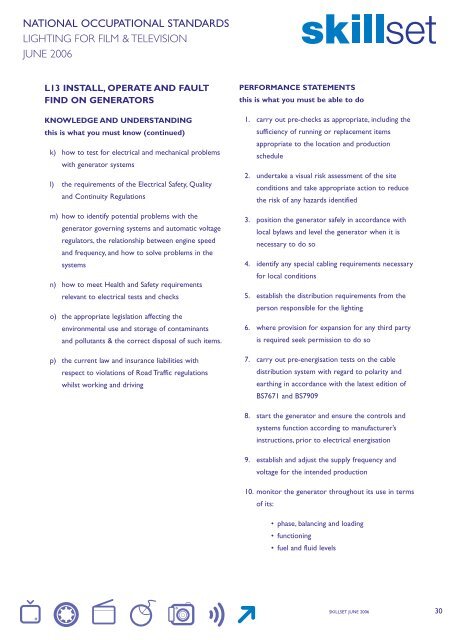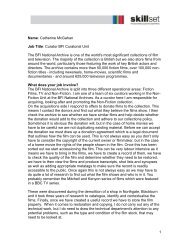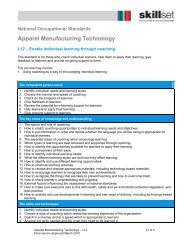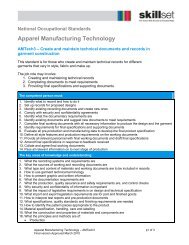National Occupational Standards - Lighting for Film and ... - Skillset
National Occupational Standards - Lighting for Film and ... - Skillset
National Occupational Standards - Lighting for Film and ... - Skillset
Create successful ePaper yourself
Turn your PDF publications into a flip-book with our unique Google optimized e-Paper software.
NATIONAL OCCUPATIONAL STANDARDS<br />
LIGHTING FOR FILM & TELEVISION<br />
JUNE 2006<br />
L13 INSTALL, OPERATE AND FAULT<br />
FIND ON GENERATORS<br />
KNOWLEDGE AND UNDERSTANDING<br />
this is what you must know (continued)<br />
k) how to test <strong>for</strong> electrical <strong>and</strong> mechanical problems<br />
with generator systems<br />
l) the requirements of the Electrical Safety, Quality<br />
<strong>and</strong> Continuity Regulations<br />
m) how to identify potential problems with the<br />
generator governing systems <strong>and</strong> automatic voltage<br />
regulators, the relationship between engine speed<br />
<strong>and</strong> frequency, <strong>and</strong> how to solve problems in the<br />
systems<br />
n) how to meet Health <strong>and</strong> Safety requirements<br />
relevant to electrical tests <strong>and</strong> checks<br />
o) the appropriate legislation affecting the<br />
environmental use <strong>and</strong> storage of contaminants<br />
<strong>and</strong> pollutants & the correct disposal of such items.<br />
p) the current law <strong>and</strong> insurance liabilities with<br />
respect to violations of Road Traffic regulations<br />
whilst working <strong>and</strong> driving<br />
PERFORMANCE STATEMENTS<br />
this is what you must be able to do<br />
1. carry out pre-checks as appropriate, including the<br />
sufficiency of running or replacement items<br />
appropriate to the location <strong>and</strong> production<br />
schedule<br />
2. undertake a visual risk assessment of the site<br />
conditions <strong>and</strong> take appropriate action to reduce<br />
the risk of any hazards identified<br />
3. position the generator safely in accordance with<br />
local bylaws <strong>and</strong> level the generator when it is<br />
necessary to do so<br />
4. identify any special cabling requirements necessary<br />
<strong>for</strong> local conditions<br />
5. establish the distribution requirements from the<br />
person responsible <strong>for</strong> the lighting<br />
6. where provision <strong>for</strong> expansion <strong>for</strong> any third party<br />
is required seek permission to do so<br />
7. carry out pre-energisation tests on the cable<br />
distribution system with regard to polarity <strong>and</strong><br />
earthing in accordance with the latest edition of<br />
BS7671 <strong>and</strong> BS7909<br />
8. start the generator <strong>and</strong> ensure the controls <strong>and</strong><br />
systems function according to manufacturer’s<br />
instructions, prior to electrical energisation<br />
9. establish <strong>and</strong> adjust the supply frequency <strong>and</strong><br />
voltage <strong>for</strong> the intended production<br />
10. monitor the generator throughout its use in terms<br />
of its:<br />
• phase, balancing <strong>and</strong> loading<br />
• functioning<br />
• fuel <strong>and</strong> fluid levels<br />
SKILLSET JUNE 2006<br />
30

















